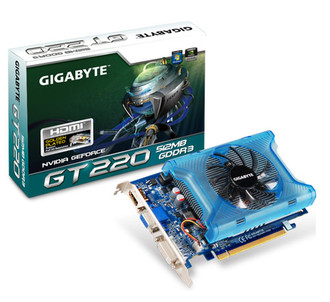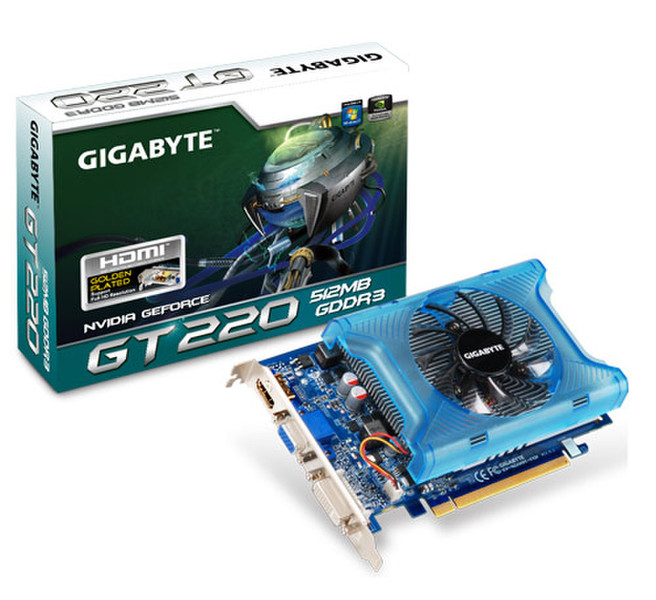Catalog
-
Catalog
- Antiquitäten & Kunst
- Auto & Motorrad: Fahrzeuge
- Baby
- Business & Industry
- Bücher
- Camping & Outdoor
- Feinschmecker
- Garten & Terrasse
- Haushalt & Wohnen
- Haustierbedarf
- Heimwerken & Garten
- HiFi & Audio
- Home, Construction, Renovation
- Household appliances
- Kleidung & Accessoires
- Modellbau
- Musik
- PC- & Videospiele
- Photo & camcorders
- Sammeln & Seltenes
- Spielzeug
- TV, Video, DVD
- Telekommunikation
- Uhren & Schmuck
- Wellness & Beauty
- computers & electronics
- entertainment & hobby
- fashion & lifestyle
- food, beverages & tobacco
- garden & patio
- health & beauty
- institutional food services equipment
- medical equipment, accessories & supplies
- office
- sports & recreation
- vehicles & accessories
- weapons & ammunition
Filters
Search

Gigabyte GeForce GT 220 GeForce GT 220 GDDR3
MPN: GV-N220OC-512I
🚚 Select the country of delivery:
Delivery from:
Germany
Sale and delivery by:
Where to buy and prices (Advertising *)
On Top
Technical specifications
On Top
Processor
| Processor frequency | 680 MHz |
|---|---|
| Graphics processor family | NVIDIA |
| CUDA | Y |
| Maximum analog resolution | 2048 x 1536 pixels |
| Shader clock | 1480 MHz |
Memory
| Graphics adapter memory type | GDDR3 |
|---|---|
| Memory bus | 128 bit |
| Memory clock speed | 2000 MHz |
Performance
| DirectX version | 10.1 |
|---|---|
| OpenGL version | 3.1 |
| Shader model version | 4.1 |
| PhysX | Y |
| TV tuner integrated | N |
| HDCP | Y |
Other features
| HDMI | Y |
|---|---|
| Mac compatibility | N |
Ports & interfaces
| Interface type | PCI Express 2.0 |
|---|---|
| HDMI ports quantity | 1 |
| VGA (D-Sub) ports quantity | 1 |
Design
| Cooling type | Active |
|---|
Additionally
| Graphics controller | GeForce GT 220 |
|---|---|
| Dual-link DVI | Y |
GeForce GT 220, 680MHz, GDDR3, 2000MHz, 2560x1600, PCI-E 2.0, DirectX 10.1, OpenGL 3.1
Microsoft Window7
Microsoft Windows 7 is the next generation operating system that will mark a dramatic improvement in the way the OS takes advantage of the graphics processing unit (GPU) to provide a more compelling user experience. By taking advangate of the GPU for both graphics and computing, Windows 7 will not only make todays's PCs more visual and more interactive but also ensure that they have the speed and responsiveness customers want.
Windows Vista
NVIDIA's fourth-gereration GPU architecture built for Windows Vista gives users the best possible experience with the Windows Aero 3D graphical user interface.
RoHS Compliant
As a citizen of the global village, GIGABYTE exert ourselves to be a pioneer in environment care. Give the whole of Earth a promise that our products do not contain any of the restricted substances in concentrations and applications banned by the RoHS Directive, and are capable of being worked on at the higher temperatures required for lead free solder. One Earth and GIGABYTE Cares!
OpenGL 3.1® Optimizations
Ensure top-notch compatibility and performance for all OpenGL 3.1 application.
Microsoft® DirectX® 10.1
World's first DirectX 10.1 GPU with full Shader Model 4.0 support delivers unparalleled levels of graphics realims and film-quality effects.
Shader Model 4.1
Shader Model 4.1 adds support for indexed temporaries which can be quite useful for certain tasks.Regular direct temporary access is preferable is most cases. One reason is that indexed temporaries are hard to optimize. The shader optimizer may not be able to identify optimizations across indexed accesses that could otherwise have been detected. Furthermore, indexed temporaries tend to increase register pressure a lot. An ordinary shader that contains for instance a few dozen variables will seldom consume a few dozen temporaries in the end but is likely to be optimized down to a handful depending on what the shader does. This is because the shader optimizer can easily track all variables and reuse registers. This is typically not possible for indexed temporaries, thus the register pressure of the shader may increase dramatically. This could be detrimental to performance as it reduces the hardware’s ability to hide latencies.
PCI-E 2.0
PCI Express® 2.0 –Now you are ready for the most demanding graphics applications thanks to PCI Express® 2.0 support, which allows up to twice the throughput of current PCI Express® cards. Doubles the bus standard's bandwidth from 2.5 Gbit/s (PCIe 1.1) to 5 Gbit/sec.
GigaThread™ Technology
Massively multi-threaded architecture supports thousands of independent simultaneous threads, providing extreme processing efficiency in advanced, next generation shader programs.
HDCP Support
High-Bandwidth Digital Content Protection (HDCP) is a form of copy protection technology designed to prevent transmission of non-encrypted high-definition content as it travels across DVI or HDMI digital connections.
HDMI Ready
High Definition Multimedia Interface (HDMI) is a new interface standard for consumer electronics devices that combines HDCP-protected digital video and audio into a single, consumer-friendly connector.
PureVideo™
PureVideo™ technology ensures support for new video formats, while its motion estimation engine (MEE) allows the card to record and play video files simultaneously without interrupting system performance. An added value PureVideo™ provides is its high-definition MPEG-2 and WMV HD hardware accelerator that take on much of the heavy lifting during playback of Hi-Def video. Other video playback enhancements include a unique color correction mechanism that will help to create a home theater from a PC.
CUDA Technology
NVIDIA® CUDA™ technology unlocks the power of the hundreds of cores in your NVIDIA® GeForce® graphics processor (GPU) to accelerate some of the most performance hungry computing applications. The CUDA™ technology already adopted by thousands of programers to speed up those performance hungry computing applications.
PhyX Technology
NVIDIA® PhysX™ is the next big thing in gaming!The best way to get real-time physics, such as explosions that cause dust and debris, characters with life-like motion or cloth that drapes and tears naturally is with an NVIDIA® PhysX™-ready GeForce® processor
Dual-link DVI
Able to drive two of the industry's largest and highest resolution flat-panel displays up to 2560x1600.
Microsoft Windows 7 is the next generation operating system that will mark a dramatic improvement in the way the OS takes advantage of the graphics processing unit (GPU) to provide a more compelling user experience. By taking advangate of the GPU for both graphics and computing, Windows 7 will not only make todays's PCs more visual and more interactive but also ensure that they have the speed and responsiveness customers want.
Windows Vista
NVIDIA's fourth-gereration GPU architecture built for Windows Vista gives users the best possible experience with the Windows Aero 3D graphical user interface.
RoHS Compliant
As a citizen of the global village, GIGABYTE exert ourselves to be a pioneer in environment care. Give the whole of Earth a promise that our products do not contain any of the restricted substances in concentrations and applications banned by the RoHS Directive, and are capable of being worked on at the higher temperatures required for lead free solder. One Earth and GIGABYTE Cares!
OpenGL 3.1® Optimizations
Ensure top-notch compatibility and performance for all OpenGL 3.1 application.
Microsoft® DirectX® 10.1
World's first DirectX 10.1 GPU with full Shader Model 4.0 support delivers unparalleled levels of graphics realims and film-quality effects.
Shader Model 4.1
Shader Model 4.1 adds support for indexed temporaries which can be quite useful for certain tasks.Regular direct temporary access is preferable is most cases. One reason is that indexed temporaries are hard to optimize. The shader optimizer may not be able to identify optimizations across indexed accesses that could otherwise have been detected. Furthermore, indexed temporaries tend to increase register pressure a lot. An ordinary shader that contains for instance a few dozen variables will seldom consume a few dozen temporaries in the end but is likely to be optimized down to a handful depending on what the shader does. This is because the shader optimizer can easily track all variables and reuse registers. This is typically not possible for indexed temporaries, thus the register pressure of the shader may increase dramatically. This could be detrimental to performance as it reduces the hardware’s ability to hide latencies.
PCI-E 2.0
PCI Express® 2.0 –Now you are ready for the most demanding graphics applications thanks to PCI Express® 2.0 support, which allows up to twice the throughput of current PCI Express® cards. Doubles the bus standard's bandwidth from 2.5 Gbit/s (PCIe 1.1) to 5 Gbit/sec.
GigaThread™ Technology
Massively multi-threaded architecture supports thousands of independent simultaneous threads, providing extreme processing efficiency in advanced, next generation shader programs.
HDCP Support
High-Bandwidth Digital Content Protection (HDCP) is a form of copy protection technology designed to prevent transmission of non-encrypted high-definition content as it travels across DVI or HDMI digital connections.
HDMI Ready
High Definition Multimedia Interface (HDMI) is a new interface standard for consumer electronics devices that combines HDCP-protected digital video and audio into a single, consumer-friendly connector.
PureVideo™
PureVideo™ technology ensures support for new video formats, while its motion estimation engine (MEE) allows the card to record and play video files simultaneously without interrupting system performance. An added value PureVideo™ provides is its high-definition MPEG-2 and WMV HD hardware accelerator that take on much of the heavy lifting during playback of Hi-Def video. Other video playback enhancements include a unique color correction mechanism that will help to create a home theater from a PC.
CUDA Technology
NVIDIA® CUDA™ technology unlocks the power of the hundreds of cores in your NVIDIA® GeForce® graphics processor (GPU) to accelerate some of the most performance hungry computing applications. The CUDA™ technology already adopted by thousands of programers to speed up those performance hungry computing applications.
PhyX Technology
NVIDIA® PhysX™ is the next big thing in gaming!The best way to get real-time physics, such as explosions that cause dust and debris, characters with life-like motion or cloth that drapes and tears naturally is with an NVIDIA® PhysX™-ready GeForce® processor
Dual-link DVI
Able to drive two of the industry's largest and highest resolution flat-panel displays up to 2560x1600.
-
Payment Methods
We accept:










